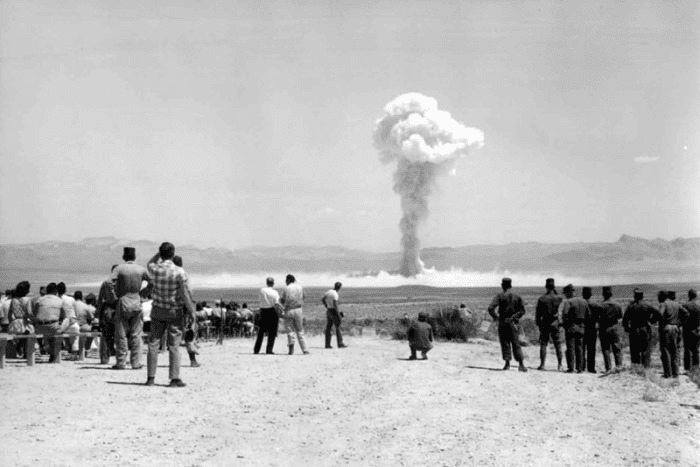CW: Discussions of colonial violence.
In the wake of Hiroshima, every major power on Earth scrambled to develop nuclear weapons to maintain military relevance. One such country was Britain, and in a bid to strengthen Australia’s relationship with Brits, the Menzies government offered swathes of land for nuclear testing. The areas chosen were predominantly inhabited by First Nations people.
Testing in Australia was carried out in three locations: Montebello Islands, Emu Field, and Maralinga, between 1952 and 1957. A total of twelve major atomic detonations occurred, creating large fireballs and mushroom clouds that released radioactive debris that is still detectable today. The explosions were similar in size to those seen at Hiroshima and Nagasaki.
Maralinga faced seven atomic detonations and hundreds of smaller-scale experiments which developed weapons and safety systems for Western powers. These minor trials dispersed radioactive material, including plutonium and uranium, across these sites.
The entire program was characterised by poor safety for everyone involved. Some experiments involved RAAF planes flying through mushroom clouds to sample the radiation. The personnel were untrained, did not have adequate monitoring devices, and, in some cases, were sent out without protective equipment.
For the surrounding communities, the testing also posed, and poses, significant health risks.
Nuclear fallout is a mix of unfissioned material and radioactive material produced during the explosion (such as cesium-137). Radioactive chemicals do not degrade the way that other explosives byproducts do. Instead, they have ‘half-lives’ which denote the time taken for half of the radioactive material to decay and become inactive (or decay into another lower-weight radioactive compound). Large amounts of plutonium-239 were dispersed during these tests.
Initially, unfissioned plutonium-239 was thought to be relatively harmless. However, recent research from Monash University indicates otherwise. When larger plutonium particles enter the atmosphere, they can release radioactive nanoparticles which spread across the environment attached to dust or rain. As wildlife take up this plutonium from the soil, it is believed to slowly release into other flora and fauna — with dangerous implications for people living on Country. This is particularly concerning considering the 24,100 year half-life of plutonium-239.
In the lead up to the tests, British Armed Forces failed to warn First Nations people of the dangers associated with the program. Only one officer was responsible for covering the thousands of square kilometres to inform whoever he could find. The officer, Walter MacDougall, was then criticised by the Chief Scientists, who wrote that “he is apparently placing the affairs of a handful of natives above those of the British Commonwealth of Nations.”
From 1955 to 1985 the Anangu people of Maralinga Tjarutja were displaced to the nearby Lutheran Mission. While the British’s Operation Brumby attempted to dilute the high concentrations of radioactive material now embedded in the land, concerns about remaining contamination lingered.
In 1985, the McLelland Royal Commission proved that further decontamination efforts were needed. The Royal Commission also criticised the complicity of the Australian Government and its lack of safety concerns. Eight years later, the British Government made a $35 million payment to the $101 million cleanup cost. The process involved the removal and off-site decontamination of hundreds of thousands of cubic metres of soil before its reburial.
The Maralinga Technical Advisory Committee was thus formed to oversee remediation. Decontamination efforts were hindered by the reluctance of the British to accurately disclose the location and extent of testing. Fortunately, only 120 square kilometres of the contaminated 3200 remained unremediated in the year 2000, with clean up and monitoring efforts ongoing today.
Between 2001 and 2009, the South Australian and Federal governments entered negotiations with the Anangu people, ensuring that they would be able to safely return to Country. Anangu people had to prove that they could monitor for erosion, damage or contamination before being officially granted land back.
The disaster of Maralinga is disturbingly familiar. Today, just like in the 1950s, the settler-colonial state of Australia is abusing Country, leaving it victim to climate change-induced fires and floods. We see the deferral of responsibility to Traditional Owners who, yet again, are cleaning up the mess of ongoing colonial violence. In both cases, the struggle for Indigenous land rights must also be a struggle to restore what has been socially and environmentally lost to centuries of colonial damage and abuse.





